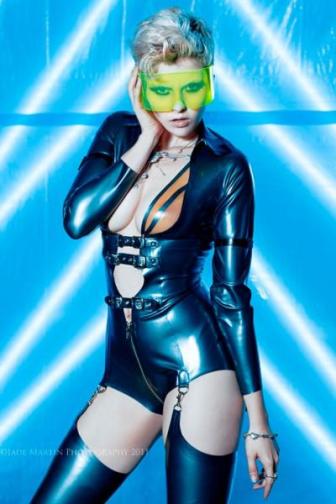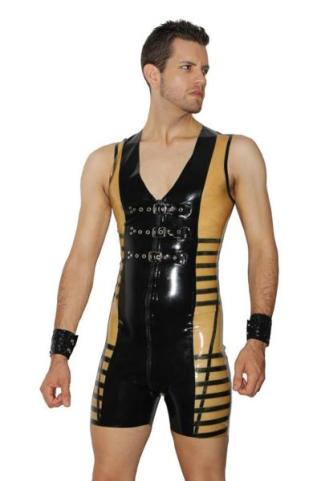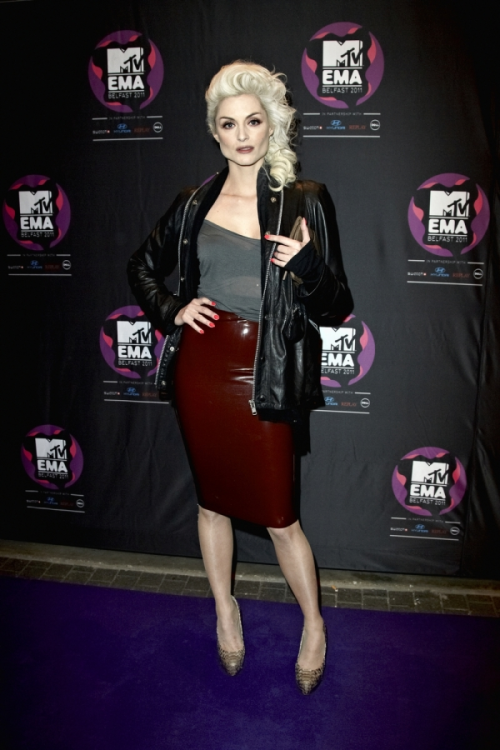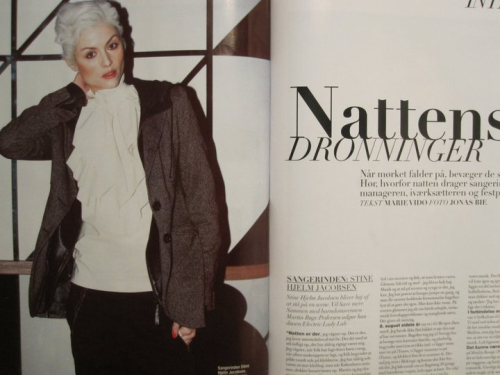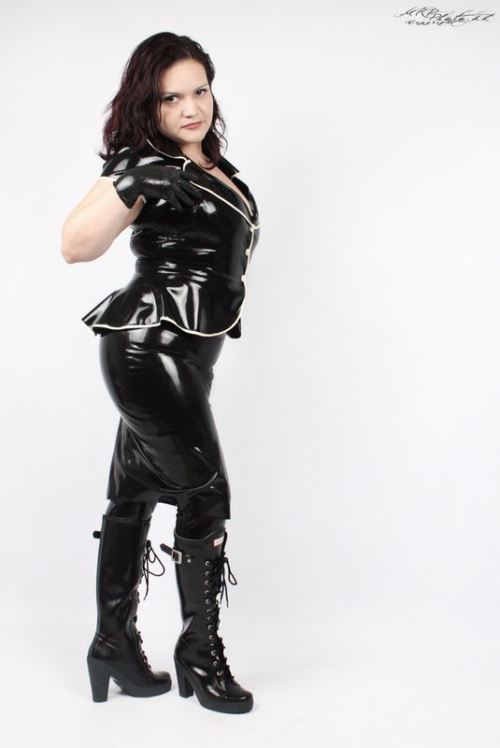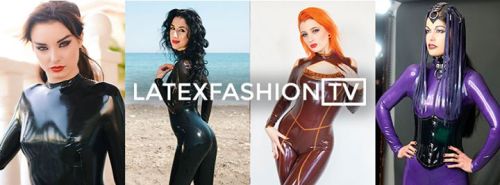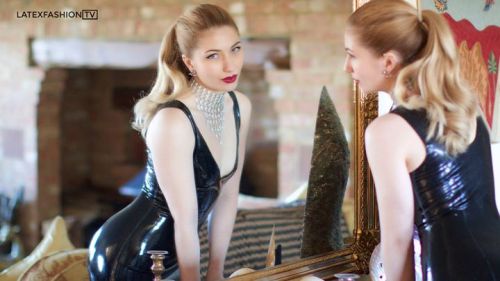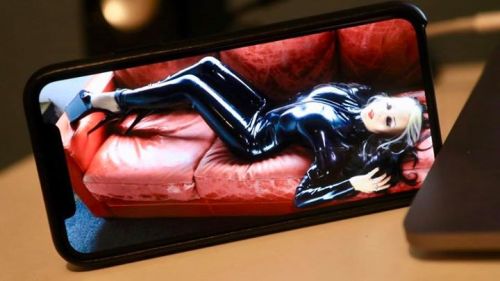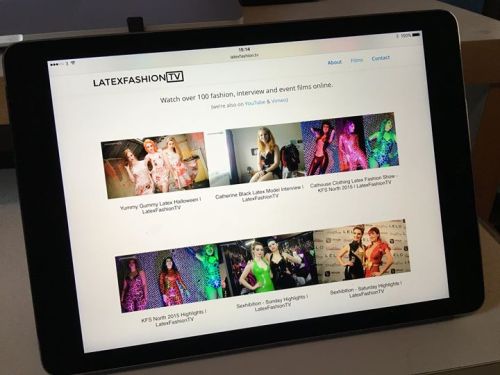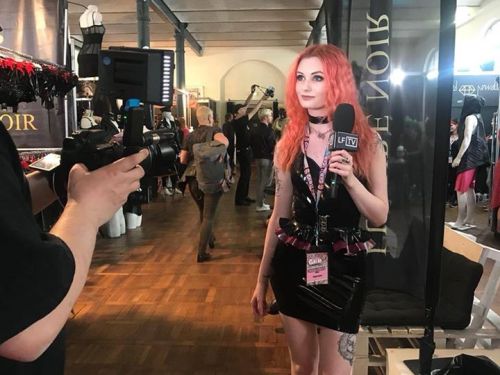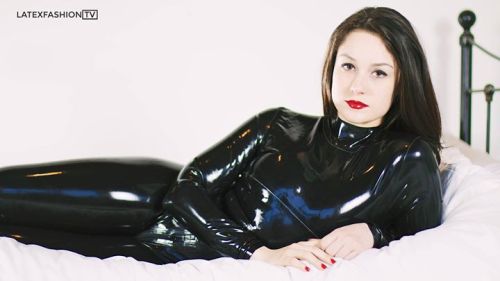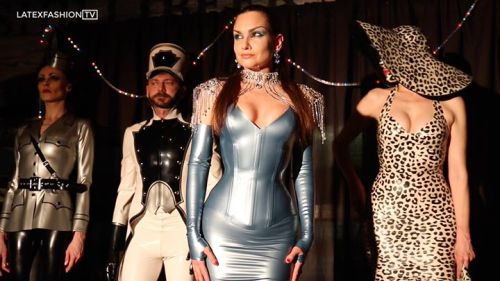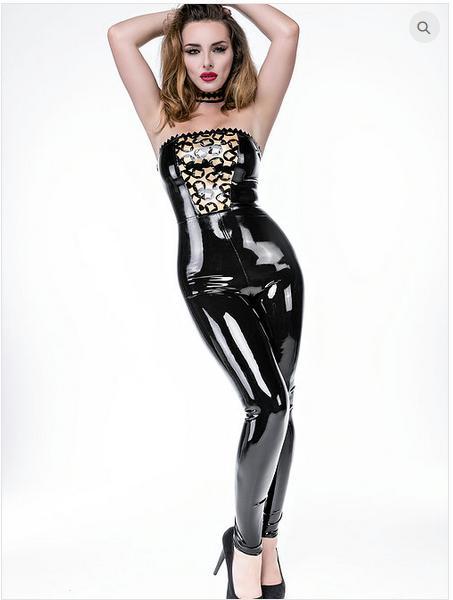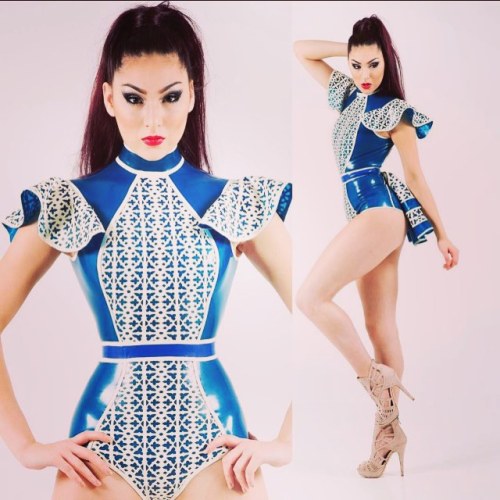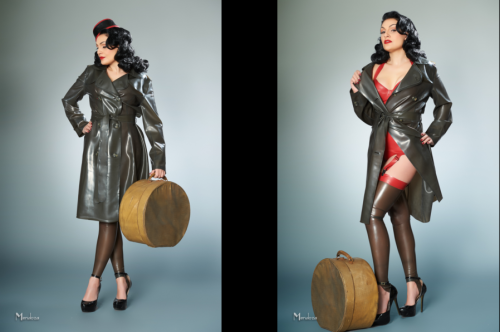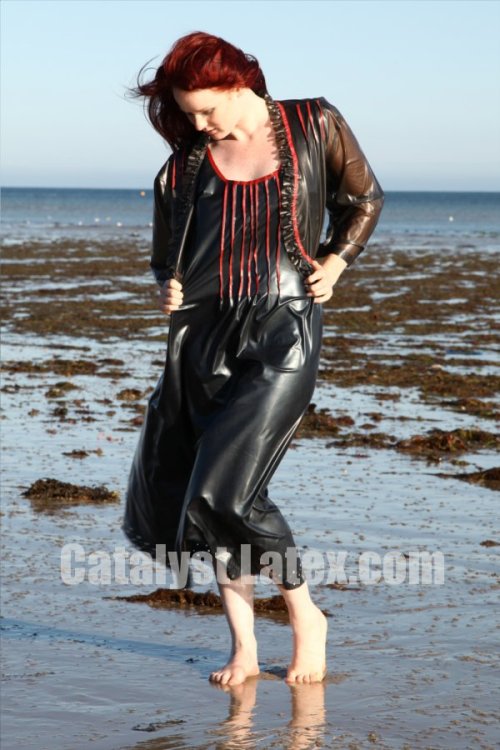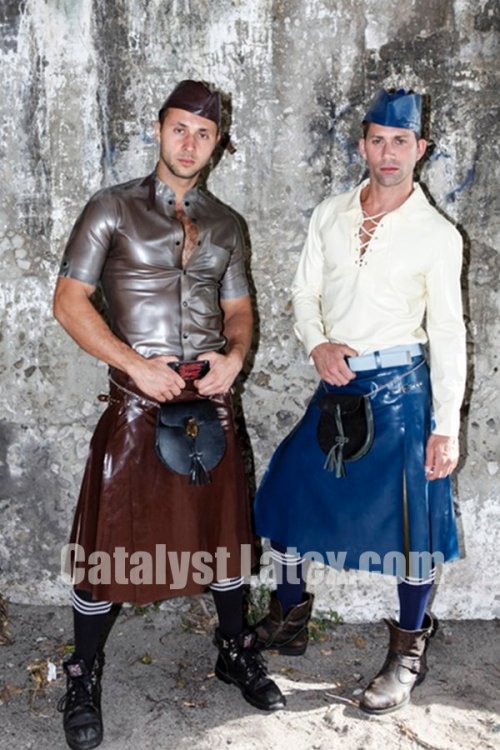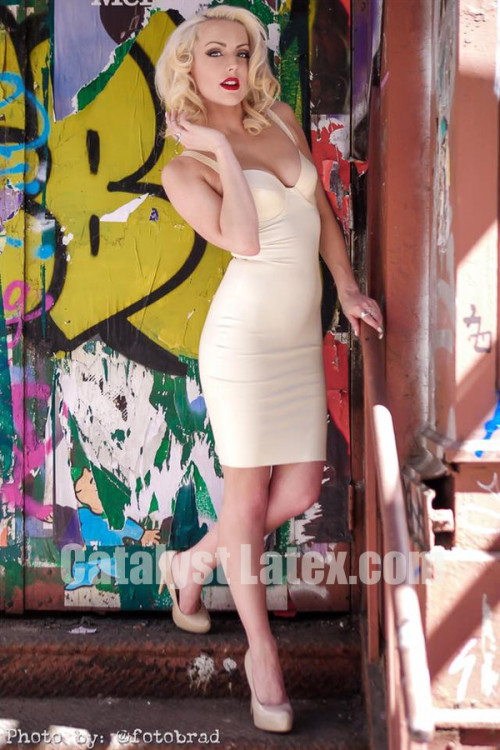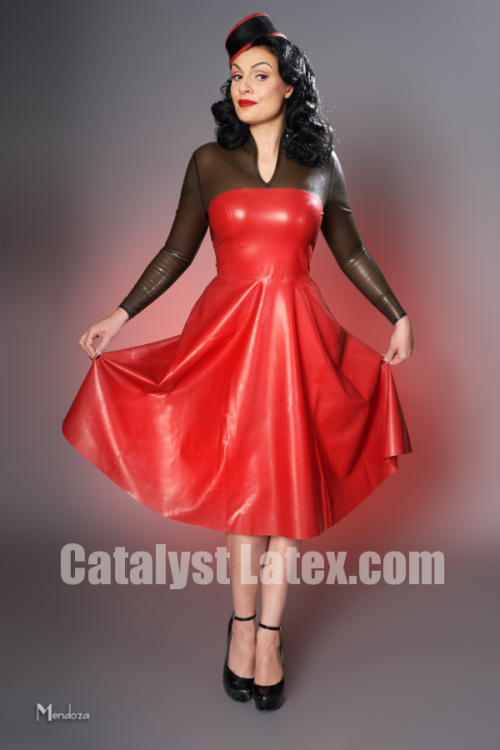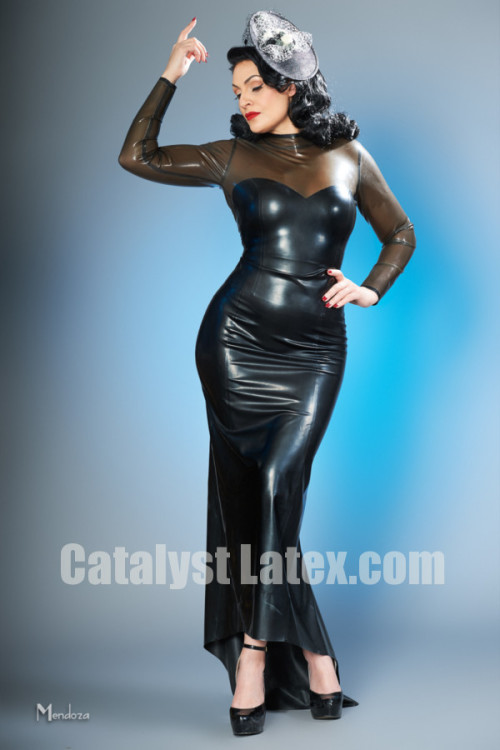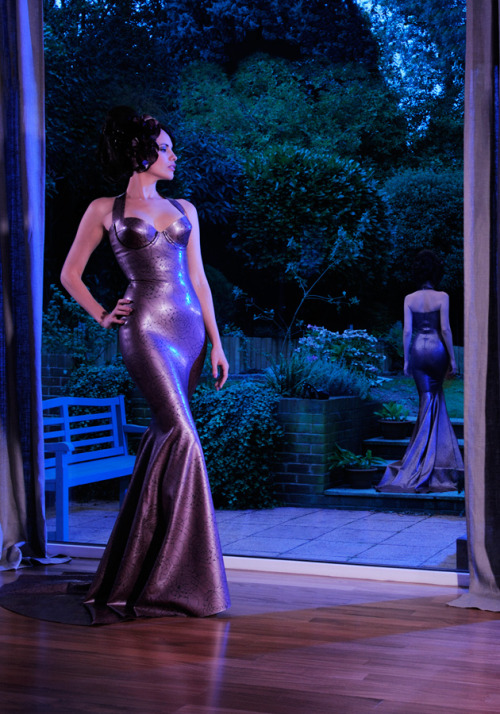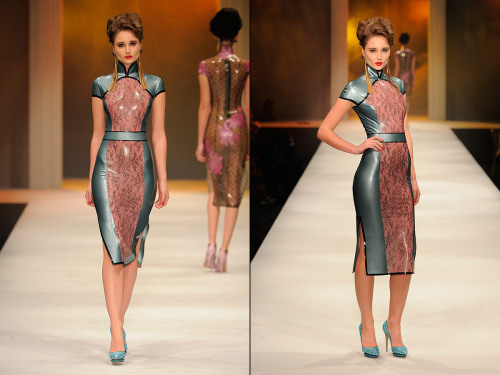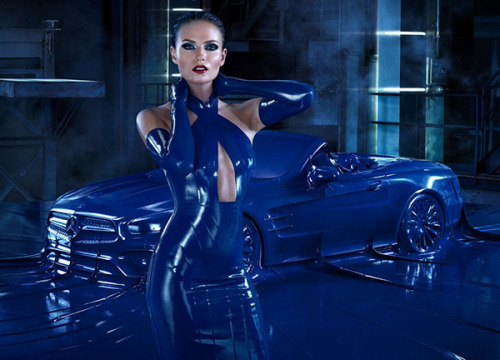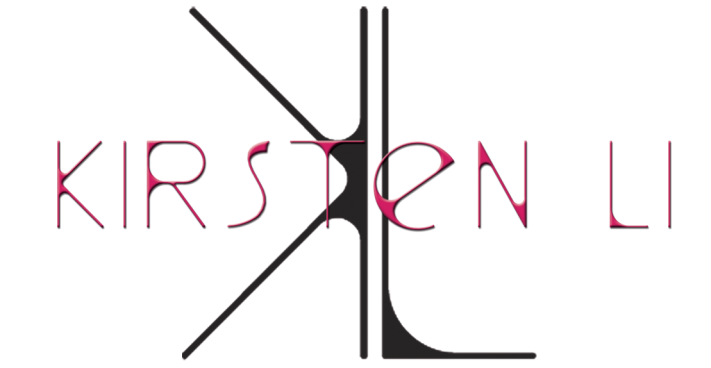
Kyle and Selina (K&S): Can you provide a short bio of your background in fashion?
Kirsten Li (KL): My name is Kirsten Li. I graduated with BFA in Fashion Design from the Fashion Institute of Technology. It was during college that I had a latex apprenticeship with The Baroness. I have over a decade of experience in the New York fashion industry, designing for a variety of companies with a specialization in knits. I currently design children’s wear for a well known denim brand in addition to custom couture latex.
K&S: How did you discover latex as a material to use in fashion? Did you have a personal interest in wearing latex or what it just a material that you found interesting?
KL: My first college roommate wanted to be a dominatrix and had a gummy latex dress. That was my first exposure to the material. I had a solid collection of PVC garments so this was like an upgrade! In 2004, I was 19, in school, and actively involved in the NYC Fetish scene. A few parties in, I was introduced to The Baroness. She happened to be in need of another assistant in her recently opened shop in the East Village, and in only a few months, I became known as The Baroness’s Assistant.
Contrary to popular belief, I do not have latex fetish; I find the material interesting – it’s very unique. I enjoy the never ending challenge to make latex look as normal as possible. Its an art and fashion medium for me.

K&S: At what point did you decide to take your personal interest in latex and transition it to a vocation?
KL: It transitioned itself without any real push from me. I worked with the Baroness for most of the time I was in school, doing a mix of patterning custom orders, helping develop new designs and crafting any orders that came through. I included latex in my college senior thesis, which attracted some friends of the Baroness and resulted in a couple commissions.
I graduated FIT in 2007 and entered the fashion industry but I never stopped crafting latex for myself. In 2010, my friend commissioned a custom dress for his girlfriend. This was the outfit that grabbed the attention of the NY Fetish Scene and more people started noticing my work.
Eventually, in 2013, I took a break from full time corporate life and started freelancing. My best friend, Ashley Bad, moved in and the two of us crafted latex together. We decided to attend Fetish Factory for the first time and this is when she really started to push me to go out on my own. I spent a few years dressing everyone I knew for FF, and my work was noticed by photographers and fetish models in attendance. I continued to take on custom orders in addition to producing two fashion shows while balancing my industry day job.
K&S: A business has a number of things that one must deal with that sometimes dim one’s passion. You have rent, insurance, utilities, materials, employee salaries etc. Is the market for latex adequate to balance the pressures of business?
KL: Owning a profitable business is hard; owning a profitable latex business is even harder. Latex is a luxury good – no one actually needs latex. I think there’s another challenge being located in the US and having to import the material from the UK.
I’m also only one person, devoting limited time to my craft. It can be challenging balancing the 9-5 life, but the rewarding part is seeing my clients glow in their latex.

K&S: What end of the market absorbs more time – the celebrity couture or the consumer market?
KL: Definitely celebrity couture. These are one of a kind outfits, that require special patterns and fittings. Its very fun to play with the ideas I’m presented with.
K&S: How do you balance your passion for creativity with the need to be profitable?
KL: My clients understand the labor that goes into custom items and are willing to compensate accordingly. I’m generally given a vague idea and they allow me to dress them with my creations.
K&S: Latex can be described as a “Fetish,” a “kink,” “Alternative fashion” or simply “fashion” Do you prefer one description over another?
KL: Its all of the above, depending on your personal preference. I design for the fashionista and I design for the fetishist, giving them an outlet to wear latex in everyday situations. I generally do not advertise my work as fetish or kink, as its designed in a “high fashion” sort of way.
K&S: Does latex, in your view, have a stereotype? Is it too “sexy” for women? Does it make women a sexual “object?” On the flip side – does it automatically get labeled as being “gay” for men?
KL: Absolutely. There’s major sex appeal attached to it, wether its positive or negative. The popularity of celebrities wearing it gives it more exposure as just another fabric that clothing can be made in.

K&S: How difficult is for latex to be perceived as something cool without creating a negative image of the wearer – be they a man or a woman.
KL: Not difficult at all. Latex is very often used in film and I’m sure many people have loved it without really knowing what it was. I push the boundaries with my designs – I want you to stop and ask, “this is latex??”
K&S: Does it bother you that for the general public, latex clothing seems to be either associated with attention seeking celebrity or “weird sex fetish”? Does the public perception make it harder for the average latex aficionado to enjoy it?
KL: I think the fact that more and more celebrities are wearing it, and promoting it as fashion, has brought latex a long way in terms of public acceptance. You do have to be aware of where your wearing it, as people have a tendency to touch the material. Its up to personal discretion.

K&S: It seems many latex outfits are designed to be body hugging. I’ve heard latex referred to as a “Second Skin.” Do you agree that latex should be used for tight outfits or does it lend itself to “loose” outfits?
KL: This is entirely up to the wearer. Latex is a fabric – it can be worn tightly or loosely. Both ways have a dramatic effect.
K&S: If it’s a “second skin” does it mean it needs to be worn without “undergarments”? Does that intimidate people from wearing it?
KL: It is something that I do and recommend for tight fitting garments, but it’s ultimately a personal preference.
K&S: In your experience, how concerned are people concerned about body image when considering fashion choices. Does latex, as a material, help or hinder these decisions?
KL: We all get dressed every day. I believe you should wear items, latex or otherwise, that make you feel the best version of you. Latex can help or hinder that: friends don’t let friends wear ill-fitting latex. My clients always tell me how amazing and confident they feel in my designs.

K&S: How do you find the market for latex wear distributed between men, women, cross-dressers (men or women), celebrity couture?
KL: Its definitely a traditionally sized women’s wear heavy market. There’s not as much plus-size or variety in menswear as I would like to see. Cross-dressers I generally recommend custom fittings.
K&S: What is your favorite piece of latex that you’ve created in your career for a man and for a woman?
KL: My Marie Antoinette overbust corset. Its full of ruffles and bows and pearls! I love mixing other materials together with latex.

K&S: People can state that they don’t like latex because of the smell, or because the material doesn’t breathe and they sweat to much, or because it’s too tight or it makes them look like they’re selling sex. How do you address those concerns?
KL: I don’t. If you’re not into latex, but are in the market for shiny clothing, I recommend PVC.
K&S: What is your design philosophy? What drives your creativity?
KL: The fabric inspires me. The challenge to make it wearable inspires me. I never stop shopping or finding inspiration. I also recently acquired a laser cutter and now there’s even more ideas!
K&S: Less or More? Do you prefer designing a latex outfit which is more on the revealing side or leaning towards full coverage? Why?
KL: Depends on my mood and/or the event. For a fetish event, I’m more inclined to wear less, while an art opening, let’s say, I’d be more covered up.
K&S: How do you feel is the best way to integrate latex into an everyday “public” outfit? How would you mix it with other materials?
KL: My latex moto jackets are my favorite item to mix in to my everyday clothing.

K&S: What are your goals for your future in latex design?
KL: For now, its my art medium. I’m not as interested in selling it as I am creating with it. Big picture, I’d like to launch a plus size line along with a tailored menswear line.
K&S: What is your favorite part of being a latex fashion designer?
KL: The endless creativity.
K&S: What is your blue sky accomplishment to achieve in the world of latex clothing or fashion in general?
KL: I’m living it now and am very grateful for being able to do so.
K&S: President Franklin D. Roosevelt stated that “We have nothing to fear but fear itself.” People tend to be fearful of things that are different. They express that fear thru aggressive or demeaning behavior towards others to express that their position is superior. Even without external pressure, a person can be fearful due to internal thoughts over how people will react.
This brings us to fashion. You can say the more different something a style is from the norm, the more people will react negatively. Do you agree with this? Is latex “too different” from what is accepted fashion to be common place?
KL: What is accepted fashion? There’s mainstream fashion then there’s avant-garde fashion. Its in the eye of the beholder.

K&S: How much more extreme is wearing latex than wearing leather? Women often wear leather to corporate jobs. Is latex that much more extreme?
KL: It depends on design of the garment. Latex can be extremely sexual and it can be conservative, as can leather. Its at the wearer’s discretion where they feel comfortable wearing their items.
K&S: Is men’s latex wear more “extreme” than women’s wear?
KL: Not necessarily. There’s so many latex companies now and they each have their specific niche in the market.
K&S: What do you say to someone who deep down would want to wear latex in public settings?
KL: You only live once!

K&S: Women’s clothing seems to have such variety. Can men’s latex be as interesting? What are your thoughts on men’s latex fashion?
KL: All my pieces for men have been tailored and easy to wear, especially for those new to the material.
K&S: A topic of discussion for some latex aficionados – Chlorination. What do you think of chlorinated latex clothing? What do you feel it does to the look, feel and smell? Is it a positive?
KL: I am not a fan of chlorination at all. The process is dangerous and it breaks down the rubber molecules. It strips the latex of its smell, blacks dull out and it will age the garment much faster. With enough practice, anyone can learn to dress in latex quickly.

K&S: Since you are based in New York City, do you have any thoughts on why such a metropolitan city appears to have few venues for latex wearers? All the latex centric events appear to be either in the United Kingdom or in Germany. Why not NYC?
KL: Unfortunately, the fetish scene here has changed drastically in the 15 years I’ve been active in it and there are not as many latex focused events as there once was. It may be due to the financial challenges of throwing an event here. Latex is still encouraged as a form of dress, but mainly for private events in the sex-positive community or at general types of fetish parties.
K&S: What would be an ideal full latex night out in NYC?
KL: Any night you want to make an impact, in my opinion!

K&S: Is there anything you would like to add? This is a totally open ended question. Feel to free to be as creative as you want with your answer.
KL: Latex can be art, it can be a fetish, it can be fashion. I believe in taking a risk, keeping an open mind, and going for things that make you feel the best version of you! Please also feel free to watch my feature on Racked!
K&S: Thank you for taking time out of your busy schedule to participate in our interview series. Best of luck on your continued success.
More Information:
Kirsten Li on Racked – “Latex is not just a Fetish Fabric”
Web: Kirsten Li Designs
Tumblr: Kirsten Li Designs
Facebook: Kirsten Li Designs



















